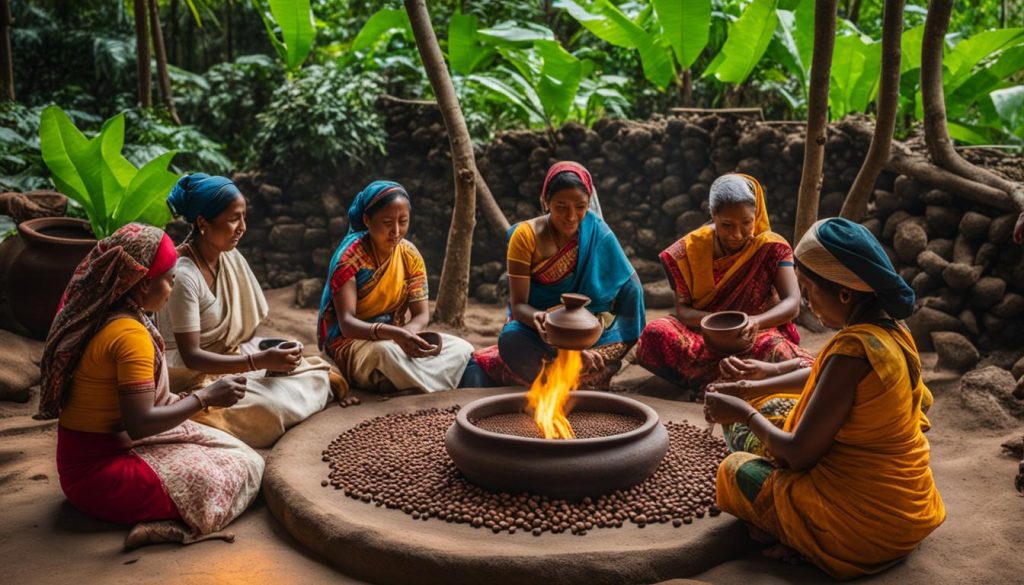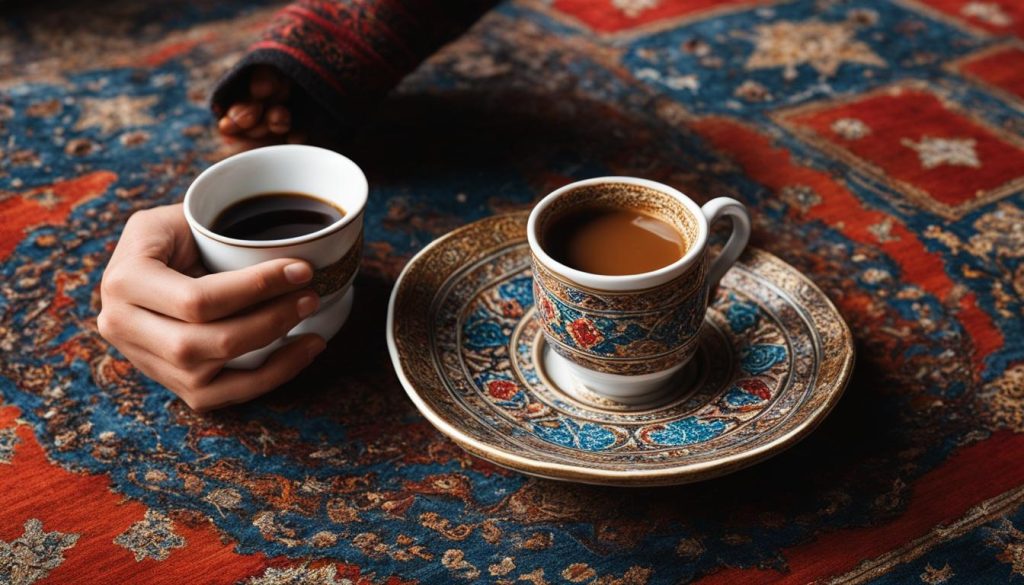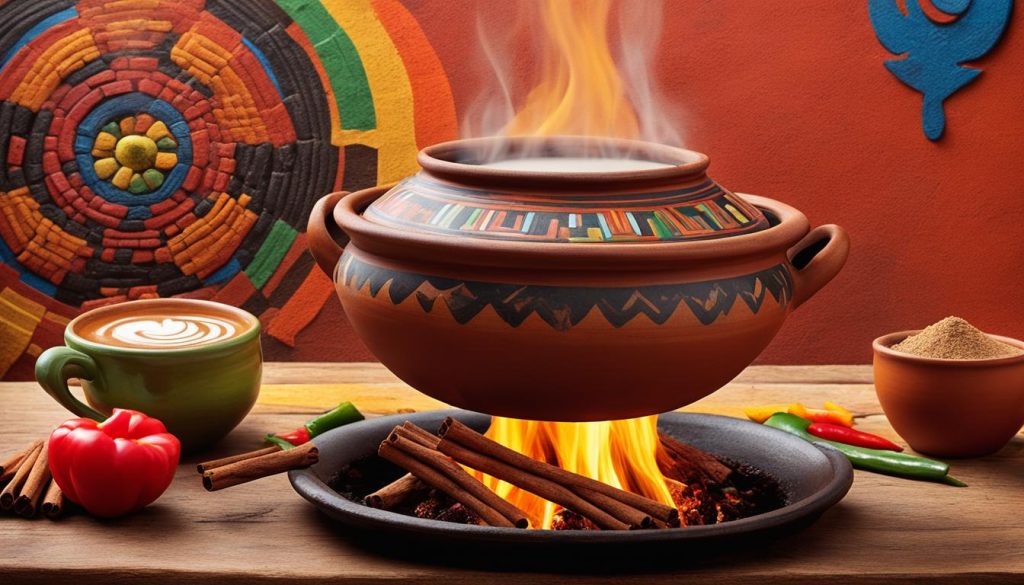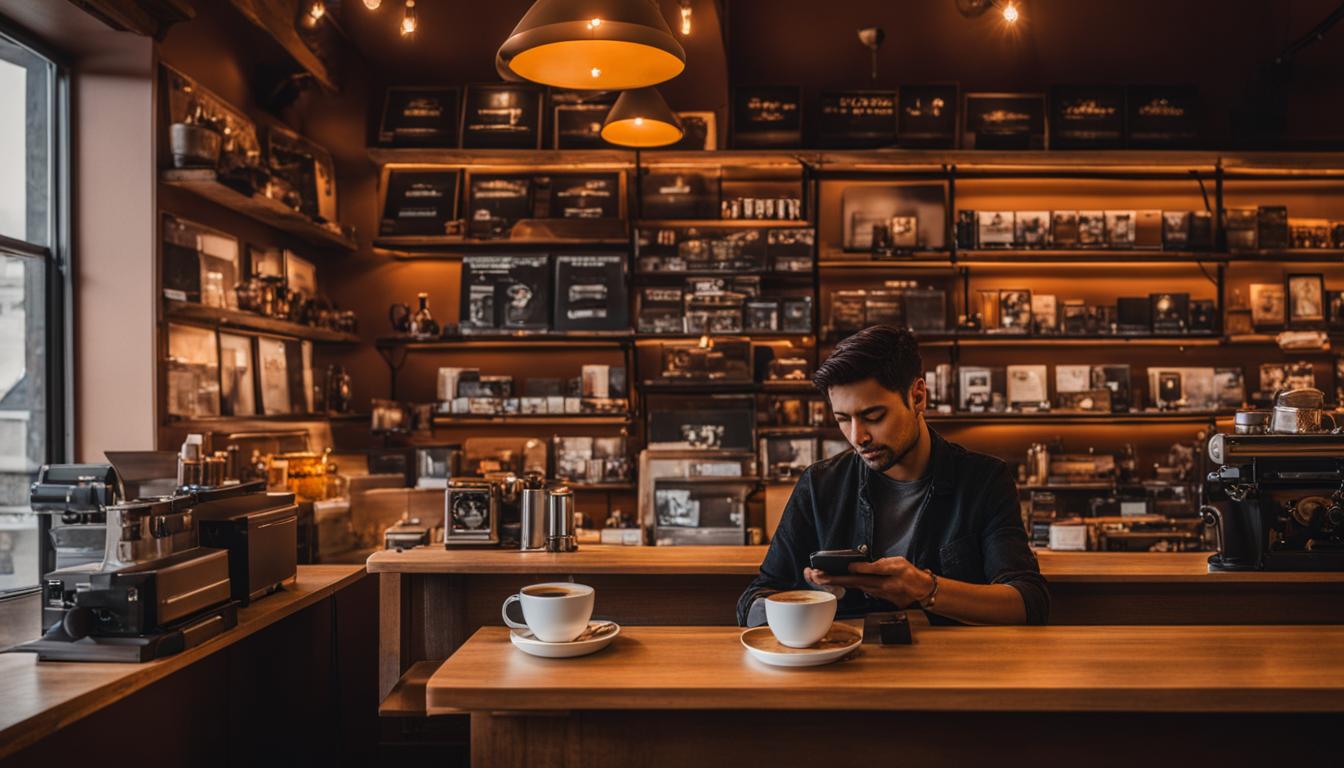As a coffee lover, I am constantly fascinated by the diverse and vibrant coffee rituals that exist around the world. From the rich cultural traditions of Ethiopian coffee ceremonies to the aromatic harmony of Middle Eastern cardamom coffee, each culture has its unique way of brewing and enjoying this beloved beverage. In this article, I will take you on a journey across different cultures to explore the global coffee customs that have been passed down through generations.
From social gatherings to spiritual practices, coffee rituals hold a special place in the hearts of people worldwide. These rituals not only bring people together but also serve as a way to connect with cultural heritage. Whether it’s the Turkish coffee reading or the Italian espresso moments, each ritual has its significance and stories to tell.
Through this exploration, you will gain a deeper understanding of the cultural coffee traditions that shape our world. Join me as we discover the beauty of these rituals and the communities they create.
Key Takeaways:
- Coffee rituals are a celebration of togetherness and cultural heritage.
- Each culture has its unique way of brewing and enjoying coffee.
- Coffee rituals hold social and spiritual significance.
- These rituals bring people together and foster a sense of community.
- Exploring coffee rituals offers insights into different cultures and traditions.
The Ethiopian Coffee Ceremony: Unity through Buna
The Ethiopian coffee ceremony, known as Buna, is a vibrant celebration that embodies the richness of Ethiopian culture and the values of community and togetherness. Buna is much more than a simple act of brewing and consuming coffee—it is a deeply ingrained tradition that fosters a sense of unity among the participants.
The Buna ceremony typically takes place in Ethiopian households, where friends and family gather to share stories, laughter, and, of course, freshly brewed coffee. The ritual begins with the roasting of the coffee beans over an open flame, often accompanied by songs and prayers.
The Ethiopian coffee ceremony, known as Buna, reflects the country’s cultural richness and values of community and togetherness.
Once the beans are roasted to perfection, they are grounded using a traditional mortar and pestle, filling the air with the warm aroma of freshly ground coffee. The finely ground coffee is then brewed in a traditional clay pot called a jebena, which is often beautifully decorated.
As the coffee brews, the aroma fills the room, creating an inviting atmosphere that draws everyone closer. The brewed coffee is poured into small cups called finjal, and each participant is served three rounds of this strong, flavorful beverage. The pouring is done with great care and often accompanied by a heartfelt blessing.
Buna is not solely about the coffee itself but also the act of coming together and appreciating the art of conversation and storytelling. It serves as a reminder of shared heritage and an opportunity to strengthen the bonds of community.
In the words of Ethiopian author Maaza Mengiste, “The Ethiopian coffee ceremony is not just about the coffee, but also the companionship, the music, the laughter.”
| Components of the Ethiopian Coffee Ceremony | Significance |
|---|---|
| Roasting of coffee beans | Symbolizes the warmth and hospitality of Ethiopian culture |
| Grinding of coffee beans | Represents the hard work and craftsmanship that goes into making a perfect cup of coffee |
| Brewing in a traditional clay pot | Reflects the connection to nature and the use of traditional utensils that have been passed down through generations |
| Sharing of stories and laughter | Strengthens bonds among participants and fosters a sense of community |
The Ethiopian coffee ceremony, with its emphasis on tradition, community bonding, and the sharing of experiences, is truly a unique and special way to appreciate the cultural heritage of Ethiopia and the significance of coffee in their everyday lives.

Turkish Coffee Reading: Fortunes in the Sediments
Turkish coffee reading, also known as tasseography, is an ancient tradition rooted in divination. The sediments left in the cup after drinking the coffee are interpreted to reveal insights into the future. This practice promotes cross-cultural understanding and deep conversations among friends and family.
“As the steam rises, secrets unfold. Turkish coffee reading is a window into the hidden realms of destiny.” – Yasmine Farouk, Coffee Culture Explorations
Whether it’s a cozy family gathering, a social event, or a casual meeting at a coffee shop, Turkish coffee reading adds an element of mystery and intrigue. As the thick, aromatic coffee is enjoyed, the leftover sediments settle at the bottom of the cup, forming unique patterns that serve as the basis for divination.
Holding the cup in one hand and swirling it gently in a counterclockwise motion, the person consuming the coffee transfers their energy and intentions into the cup. Once finished, the cup is turned upside down onto a saucer, allowing the sediments to create intricate shapes and symbols.
Then comes the intriguing part. An experienced fortune teller, or a gifted individual within the social group, skillfully analyzes the patterns and symbols to unveil messages about the person’s future, relationships, and various aspects of their life. With a deep understanding of symbolism and intuition, the fortune teller deciphers the hidden meanings within the coffee sediments.
The Art of Tasseography
Turkish coffee reading is not just a predictive art but a dynamic exchange of ideas and interpretations. The fortune teller does not provide fixed predictions but instead offers guidance and insights based on the individual’s unique circumstances.
It is important to note that Turkish coffee reading is not a science or a proven method of divination. Instead, it is a cultural practice deeply ingrained in Turkish society and the surrounding regions. The art of tasseography relies on a combination of ancient symbolism, personal intuition, and the collective wisdom passed down through generations.
Through Turkish coffee reading, individuals gain a deeper understanding of themselves and their place in the world. It sparks curiosity, introspection, and often serves as a catalyst for meaningful conversations. Whether believers or skeptics, participants in the coffee reading rituals take part in a shared experience that transcends cultural boundaries.
The Cultural Significance
Turkish coffee reading is not just about predicting the future; it is a celebration of culture and community. The ritual of sharing Turkish coffee creates a sense of connection and intimacy, bringing people together in a world of laughter, storytelling, and mutual understanding.
As a cultural tradition that has stood the test of time, Turkish coffee reading serves as a reminder of the rich history and heritage of the Turkish people. It allows individuals to explore their roots while embracing the diversity and beauty of other cultures.

The art of Turkish coffee reading continues to captivate and inspire both locals and visitors alike. It invites us to slow down, appreciate the present moment, and engage in profound conversations that delve into the mysteries of the future.
Italian Espresso: The Heart of Daily Life
Espresso is deeply ingrained in Italian culture and daily life. From the morning ritual of enjoying a quick espresso at a local cafe to using espresso as a punctuation mark throughout the day, Italians savor the present moment while indulging in the flavors and aromas of this concentrated coffee.
Italian Espresso not only satisfies their caffeine cravings but also serves as a symbol of Italian hospitality. It is common to offer a cup of espresso to visitors as a gesture of warmth and friendship. Sharing a cup of espresso creates a sense of connection and invites conversation, making it an integral part of social interactions.
Espresso moments in Italy are not simply about the coffee itself, but also about the experience. Italians take pride in the art of espresso-making, with baristas skillfully crafting each shot to perfection. The aroma of freshly brewed espresso wafts through cafes, enticing passersby to step in and join the lively coffee culture.
“Espresso is more than just a cup of coffee in Italy. It’s a way of life,” said Luca Bianchi, a coffee connoisseur and owner of a traditional Italian cafe in Rome. “It represents the Italian passion for enjoying every moment, no matter how brief.”
The Italian coffee culture goes beyond just drinking espresso. It is a celebration of the senses – the rich aroma, the velvety texture, and the intense flavor. Italians appreciate the sensory experience that comes with every sip, allowing themselves to be fully present in the moment.
The Art of Italian Espresso
The art of making Italian espresso involves a precise balance of factors, from the selection of high-quality beans to the careful calibration of the espresso machine. Italian baristas are meticulous in their craft, ensuring that each shot of espresso delivers a bold and robust flavor with a perfect crema on top.
The Italian Espresso National Institute (Istituto Nazionale Espresso Italiano) has established rigorous standards to certify and protect the authenticity and quality of Italian espresso. These standards guarantee that every cup of espresso is a true reflection of the Italian coffee tradition.
Italian espresso has gained worldwide recognition for its excellence, becoming a symbol of Italy’s culinary heritage. Whether enjoyed alone or in the company of friends and family, Italian espresso is a cherished part of daily life and a testament to the country’s passion for coffee.
Mexican Cafe de Olla: A Taste of Tradition
Cafe de Olla is a traditional Mexican coffee preparation that holds a special place in the hearts and cups of coffee lovers across Mexico. The name “Cafe de Olla” translates to “coffee from the pot” in English, emphasizing its unique brewing method.

What sets Cafe de Olla apart is its traditional way of brewing. The coffee is made using cinnamon sticks and is often brewed in earthenware clay pots, adding a distinct flavor and aroma to the brew. This brewing process has been passed down through generations, preserving the authenticity and cultural significance of this beloved Mexican coffee.
The origins of Cafe de Olla date back to the time of the Mexican revolution when it served as a source of energy for soldiers on the battlefield. The coffee houses of Mexico also became gathering places for political discussions, fostering a sense of camaraderie and contributing to the development of the nation’s independence.
Today, Cafe de Olla continues to be cherished in small country villages, where the brewing process remains true to its roots. The coffee is often enjoyed alongside traditional Mexican pastries, creating a delightful and comforting combination.
“Cafe de Olla offers more than just a cup of coffee; it represents our heritage, our history, and our love for traditional flavors.” – Juan Perez, a Mexican coffee enthusiast
The Richness of Mexican Cafe de Olla
Here’s a glimpse into the rich flavors and cultural significance of Mexican Cafe de Olla:
| Flavor Profile | Aroma | Preparation Method |
|---|---|---|
| Rich and bold with a hint of sweetness | Aromatic notes of cinnamon and earthy tones | Brewed using cinnamon sticks in an earthenware clay pot |
With its distinct flavors, Cafe de Olla showcases the unique essence of Mexican coffee culture. From its historical significance to the traditional brewing method, this coffee preparation is a true testament to Mexico’s vibrant heritage and love for rich, authentic flavors.
Vietnamese Egg Coffee: A Unique Indulgence
Vietnamese egg coffee is a culinary innovation that has captured the hearts of coffee enthusiasts around the world. This indulgent beverage combines the rich flavors of coffee with the velvety smoothness of egg yolks, creating a unique and unforgettable experience for the taste buds.
Originating in Hanoi in the 1940s, Vietnamese egg coffee was born out of necessity during a time when milk was scarce in Vietnam. Enterprising bartender Nguyen Van Giang decided to use egg yolks as a substitute for milk, resulting in a luxurious and creamy coffee creation. Little did he know that his inventive combination would become a beloved symbol of Vietnamese culture.
The process of making Vietnamese egg coffee involves whisking egg yolks with condensed milk to create a frothy custard-like mixture. This luscious concoction is then poured over a strong Vietnamese coffee, traditionally brewed in a small metal filter called a “phin.” The result is a harmonious blend of bitterness, sweetness, and creaminess that delights the senses.
In Vietnamese culture, coffee is not just a beverage, but a way of life. It is a social catalyst, bringing people together and fostering connections. Vietnamese egg coffee epitomizes this cultural reverence for coffee and showcases the country’s commitment to culinary innovation.
Vietnamese egg coffee has gained international acclaim and can now be found in cafes not only in Vietnam but also in various parts of the world. Its popularity can be attributed to its unique flavor profile, which offers a delightful departure from traditional coffee drinks. The combination of coffee and eggs may seem unconventional, but it works in perfect harmony, creating a drink that is both comforting and indulgent.
Experience the charm of Vietnamese egg coffee and indulge in its velvety goodness. Whether you’re a coffee connoisseur or simply curious about culinary innovations, this unique beverage is sure to leave a lasting impression.
| Key Characteristics of Vietnamese Egg Coffee | Benefits |
|---|---|
| Velvety texture | Offers a luxurious mouthfeel |
| Unique flavor profile | Combines the richness of coffee with the smoothness of egg yolks |
| Cultural significance | Represents Vietnam’s culinary innovation and coffee culture |
Middle Eastern Cardamom Coffee: Aromatic Harmony
Middle Eastern coffee traditions have a long-standing practice of infusing coffee with cardamom, a spice known for its aromatic and warm notes. This centuries-old tradition is a testament to the region’s rich cultural heritage and reflects the Middle Eastern love for hospitality and sharing.
The addition of cardamom to coffee creates a harmonious blend of flavors, elevating the drink to a whole new level. The spice’s herbal and citrus undertones complement the robustness of the coffee, resulting in a unique and delightful experience for the senses.
For generations, Middle Eastern households have cherished the art of brewing cardamom coffee. The process involves lightly crushing cardamom pods and adding them to the coffee grounds before brewing. This careful infusion allows the flavors to meld together, creating a rich and fragrant cup of coffee.
Whether enjoyed after a meal, as part of a social gathering, or simply as a daily indulgence, Middle Eastern cardamom coffee embodies the region’s cultural traditions and showcases its creative approach to culinary delights. So, next time you’re craving a truly aromatic and flavorful coffee experience, why not try a cup of Middle Eastern cardamom coffee?
FAQ
What are some examples of coffee rituals from different cultures?
Some examples of coffee rituals from different cultures include the Ethiopian coffee ceremony (Buna), Turkish coffee reading (tasseography), Italian espresso culture, Mexican Cafe de Olla, Vietnamese egg coffee, and Middle Eastern cardamom coffee traditions.
What is the Ethiopian coffee ceremony?
The Ethiopian coffee ceremony, known as Buna, is a ritual that involves roasting, grinding, and brewing coffee. It is a celebration of community and togetherness, accompanied by storytelling and laughter, reflecting the country’s cultural richness and values.
What is Turkish coffee reading?
Turkish coffee reading, also known as tasseography, is an ancient tradition rooted in divination. The sediments left in the cup after drinking the coffee are interpreted to reveal insights into the future. It is a practice that promotes cross-cultural understanding and deep conversations among friends and family.
How is espresso intertwined with Italian culture?
Espresso is deeply ingrained in Italian culture and daily life. Italians enjoy a morning espresso ritual at local cafes and use espresso as a punctuation mark throughout the day. It represents savoring the present moment, indulging in the flavors and aromas, and symbolizes Italian hospitality and togetherness.
What is Cafe de Olla?
Cafe de Olla is a traditional Mexican coffee preparation that uses cinnamon sticks and is often brewed in earthenware clay pots. It originated as an energy-booster for soldiers during the Mexican revolution and has become deeply rooted in Mexican culture. Coffee houses in Mexico became hubs for political discussions, contributing to the notion of independence.
What is Vietnamese egg coffee?
Vietnamese egg coffee is a unique combination of coffee and egg yolks, resulting in a velvety and indulgent beverage. It showcases Vietnam’s culinary innovation and ability to blend flavors to create unexpected delights. Vietnamese egg coffee has gained popularity in recent years and can be found in cafes across the country.
What is Middle Eastern cardamom coffee?
Middle Eastern coffee traditions often involve infusing coffee with cardamom, creating a harmonious blend of aromas and flavors. It reflects the region’s rich cultural heritage and love for hospitality and sharing. The addition of cardamom to coffee showcases the region’s creative approach to culinary traditions.



